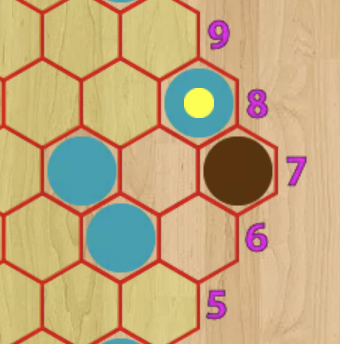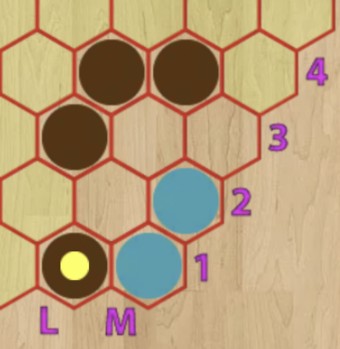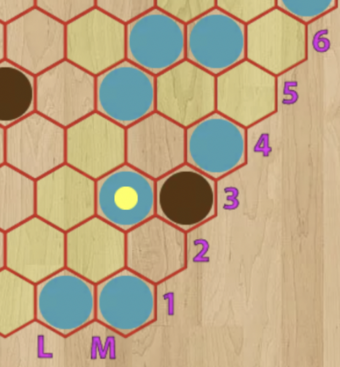This is a documentation for Board Game Arena: play board games online !
Tips oust: Difference between revisions
(Added a section on trapping attachements and images. Test if images show in BGA strategy section on main site) |
(Try to keep the images similar in size and see if it shows up on the BGA page) |
||
| Line 32: | Line 32: | ||
2) An example of a three stone group and an attachment trapping two blue stones in the corner. | 2) An example of a three stone group and an attachment trapping two blue stones in the corner. | ||
[[File:Trapping_two_stones.png]] | [[File:Trapping_two_stones.png|340px]] | ||
3) Trapping a single brown stone on the side of the board. It could only potentially grow in directions that touched two and three stone groups meaning it was trapped by the attachment. | 3) Trapping a single brown stone on the side of the board. It could only potentially grow in directions that touched two and three stone groups meaning it was trapped by the attachment. | ||
[[File:Trapping_side.png]] | [[File:Trapping_side.png|340px]] | ||
4) Here the single brown stone could only grow into size two and three groups after the attachment, and so was trapped by the attachment, this time in the centre of the board. | 4) Here the single brown stone could only grow into size two and three groups after the attachment, and so was trapped by the attachment, this time in the centre of the board. | ||
[[File:Trapping_center.png]] | [[File:Trapping_center.png|340px]] | ||
Revision as of 23:55, 27 January 2023
Overview
Oust can be a tricky game to get used to at first. The goal is to capture all your opponent's pieces, but initially there's no clear way to do this, since you can't capture or grow your own groups without your opponent's help in a sense.
Here's a brief overview of some strategic ideas and then if you wish you can read further below in a dedicated section below:
- Try to place your stones in a way that gives you more free moves than your opponent. A free move is a move that either can't be captured by your opponent, or if captured gives them little to no gain in the game.
- Restrict the opponents available moves. You don't always have to capture every stone and group of your opponent right away. If your group is strictly larger than a nearby group it could capture 2 beside 1, 3 beside 2 or 1 and so on.
- You can sacrifice some stones in the beginning of the game to make the opponents stones inefficient, that is they don't use the space around them effectively.
- Having too many more groups than your opponent can lose you the game.
- Allowing your opponent to have too large a group can lose you the game. It can be difficult, if not impossible to capture a group of about 20 stones on size 7 for instance.
- Having only small groups next to opponents larger groups can put you at a large disadvantage.
- Look out for the N+2 rule in order to take advantage of tactics, i.e. if you have a group two sizes larger than the opponents nearby groups, there may be some tactics to take advantage of. See below for examples of tactics (trapping, lead in captures, attachments).
- Some shapes are more efficient to merge groups later, but can be vulnerable to chain capturing. Be aware of this tradeoff!
Further sections detailing the above to be created and updated soon.
Tactics
This section will try to give examples of short term tactics in Oust, such as chain captures, lead-in captures, trapping and attachments.
Attachments
Typically when you play directly beside an opponents stone or group, attaching to that stone or group, you immediately make it stronger. Usually the opponent can choose a direction to grow their group after the attachment. However there are some cases where attaching has its advantages:
Trapping
The tactic of trapping, is a particular type of attachment move, taking advantage of the rule for capturing placements, whereby you need to be larger than the opponents group you touch in order to capture it. Typically with these trapping moves you attach a single stone to your opponents single stone or group, in a situation where the opponent can only grow in directions where they would touch a group of the same size or larger. In these cases the opponent can't capture and it's like the group is trapped with no legal growing/capturing placements. The following images show some examples of trapping moves:
1) The easiest place to trap an opponents group is typically in corners, since there is already a limited number of directions to grow with capturing placements. Here a two stone group and an attachment traps the single brown stone.
2) An example of a three stone group and an attachment trapping two blue stones in the corner.
3) Trapping a single brown stone on the side of the board. It could only potentially grow in directions that touched two and three stone groups meaning it was trapped by the attachment.
4) Here the single brown stone could only grow into size two and three groups after the attachment, and so was trapped by the attachment, this time in the centre of the board.



